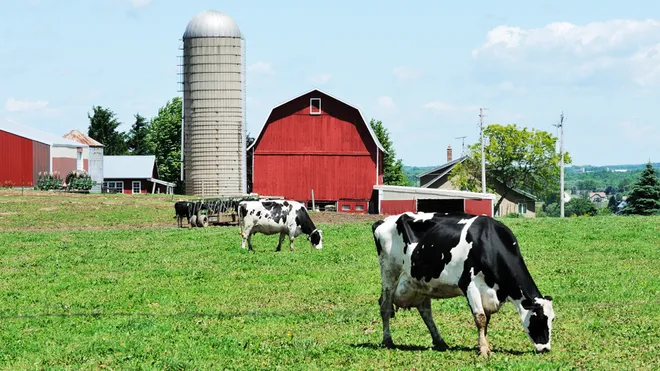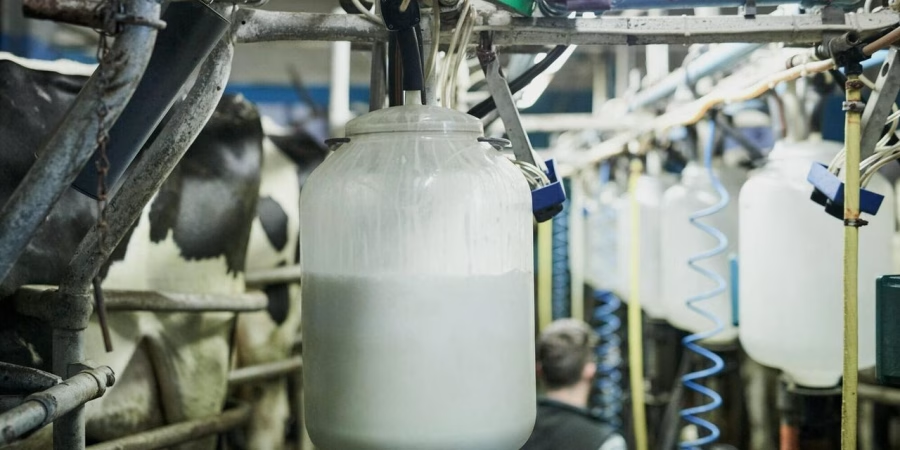Explore the potential for growth in U.S. dairy farms as profit margins rise. Will producers navigate the hurdles to take advantage of higher margins and boost output?

The U.S. dairy farming landscape is experiencing a promising revival. Producer margins have reached their highest in 18 months, as reported by the Dairy Margin Coverage (DMC) program. Despite ongoing hurdles like animal health issues and financial constraints, this surge offers a potential boost to dairy farms.
More substantial milk prices and lower feed costs have significantly improved margins. However, challenges remain, especially with tepid international demand. Addressing these concerns is essential for the future growth of the U.S. dairy industry. The insights provided here can inform strategic decisions and policies to foster resilience and profitability in this vital sector.
Surging Milk Margins and Prices Signal Positive Trends Amidst Ongoing Industry Challenges
In May, the U.S. dairy industry witnessed a positive trend, with dairy producer margins climbing to $10.52/cwt., up 92 cents from April, the highest since late 2022. The All-Milk price also rose significantly to $22/cwt., marking a $1.50 increase and the highest since January 2023. Amidst ongoing industry challenges, these gains signal a promising future for the U.S. dairy industry.
Monica Ganely Identifies the Current Rise in Margins as a Crucial Opportunity for Dairy Producers
Monica Ganely views the rise in margins as a pivotal opportunity for dairy producers. Increased margins typically encourage scaling up production to leverage higher profitability. However, Ganely points out persistent barriers like animal health issues, expensive financing, and limited replacement animals that may slow this expansion.
Despite the challenges, the dairy farming community remains resilient. Monica Ganely, for instance, is cautiously optimistic. She believes that the longer margins stay at current levels, the more likely resourceful producers will find ways to mitigate these challenges and increase production. This resilience underscores the strength of the dairy farming community and the potential for a prosperous future.
Structural Challenges Impeding Expansion Despite Favorable Margins
Despite rising margins, U.S. dairy producers face significant barriers that limit their ability to expand and benefit from improved profitability. Animal health issues like mastitis and bovine respiratory diseases threaten herd productivity and increase veterinary costs.
Economic challenges and costly financing further strain producers. High operational costs and thin profit margins necessitate substantial capital investments. However, securing affordable loans is difficult due to current financial conditions and interest rates, compounded by fluctuating market conditions and high feed costs.
A shortage of replacement animals also hinders expansion. This scarcity results from past low profitability, which discouraged herd renewal investments, and recent culling practices for immediate financial relief. Producers now need more young, productive animals to grow their herds.
Higher margins offer temporary opportunities, but long-term strategies and systemic support are essential for overcoming these entrenched barriers. The resilience and adaptability of U.S. dairy farmers will be crucial to navigating these challenges and capitalizing on favorable market conditions.
Analyzing the Current State of Feed Costs Reveals a Subtle Yet Noteworthy Uptick
Feed costs increased slightly in May, rising to $11.48 per hundredweight (cwt), 58 cents higher than in April. The uptick affected all key feed components: corn, soybean meal, and premium alfalfa. Even with this rise, May’s feed costs were about $3/cwt, lower than the same time last year and reaching their lowest since 2021. This indicates a trend of easing feed expenses following the high prices of previous years.
The Dairy Margin Coverage Program: A Crucial Financial Safety Net for U.S. Dairy Producers
The Dairy Margin Coverage (DMC) program stabilizes dairy producers’ incomes during market fluctuations. This federal program calculates the difference between the All-Milk price and the average feed cost, known as the Milk Margin Above Feed Costs. If the margin falls below a selected threshold, it triggers payments to offset the shortfall and stabilize incomes, providing a vital financial safety net for U.S. dairy producers.
Producers can enroll in the DMC program to choose coverage levels that match their financial risk tolerance. The most common threshold is $9.50 per hundredweight (cwt.). When margins drop below this level, payments help cover operating costs, ensuring farm viability during financial stress.
In essence, the DMC program offers a buffer against market volatility. With unpredictable feed costs and milk prices, the program provides financial predictability. This stability enables producers to plan and invest with confidence, enhancing the resilience and sustainability of the U.S. dairy industry.
Complex Market Dynamics and Strategic Planning: Analyzing Factors Behind the Surge in Milk Prices
The surge in milk prices stems from several key factors within the dairy industry. The significant rise in Class III and IV milk prices significantly influences. Class III milk, crucial for cheese production, increased due to strong domestic and international demand and steady spot dairy product prices. The Class III price surged over $3/cwt. Since April, they have significantly impacted the overall milk pricing structure.
Class IV milk, related to butter and nonfat dry milk, has also increased prices. This rise is due to steady butter demand and tight nonfat dry milk supplies, pushing the All-Milk price to its highest since January 2023.
However, future market trends indicate possible price declines. Futures markets predict that spot dairy product prices may not stay elevated. A drop in Class III prices is expected, which could slow recent milk revenue gains influenced by changing demand and economic conditions.
While current margins provide relief, strategic planning, and risk management are crucial for the dairy industry’s long-term success. Ganley emphasizes the need for proactive measures, such as the use of tools like the Dairy Margin Coverage program, to offer essential financial protection against unpredictable market shifts.
Lackluster U.S. Dairy Exports Weigh on Milk Prices Amid Strong Domestic Performance
One bearish factor for milk prices is lackluster U.S. dairy exports. In May, total U.S. exports fell below prior-year levels after growing in April, according to USDA’s Foreign Agricultural Service. U.S. exporters sent 504.8 million pounds of dairy products offshore, 1.7% less than in May 2023. “Weak demand from Asia weighed on total exports, even as exports to Mexico continued to soar,” Ganley said.
Cheese exports climbed 46.6% in May to 504.8 million pounds, the most recorded month, with over 40 million pounds sent to Mexico. Whey exports rose 15.2% as China’s demand for permeate and dry whey picked up, but other categories fared less. Nonfat dry milk exports slipped 24.2%, and butter exports fell 19.4% due to high prices.
The Bottom Line
As U.S. dairy producers see rising profitability with expanding margins and climbing milk prices, the industry contends with significant structural and market challenges. May’s Milk Margin Above Feed Costs reached $10.52/cwt., offering hope for dairy farmers. However, it’s essential to acknowledge that animal health issues, expensive financing, and limited access to replacement animals hinder producers from fully leveraging these improved margins. While higher milk prices drive these margins, reduced feed costs provide financial relief.
The Dairy Margin Coverage (DMC) program remains a crucial safety net, protecting farmers when margins fall below set thresholds. Nonetheless, gains in domestic profitability are countered by weak exports, mainly due to low demand from Asia, highlighting the complex dynamics in the global dairy market. This shows that even with better domestic margins, international market conditions pose a risk to sustained growth.
The industry’s future hinges on navigating these challenges. As margins stay favorable, producers must strategize to overcome barriers and increase output. While economic conditions offer a unique opportunity, strategic planning and tools like the DMC program are essential for sustained progress. The dairy sector is pivotal; addressing systemic issues and embracing innovation can lead to a more resilient and prosperous future. Producers and stakeholders must act now to secure the stability and growth of U.S. dairy farming.
Key Takeaways:
- Dairy producer margins have reached a year and a half high, signaling potential for increased output.
- Main contributors to this rise include stronger milk prices and slightly decreased feed costs compared to the previous year.
- The Dairy Margin Coverage (DMC) program provides financial safety net payments when margins fall below $9.50/cwt.
- Despite higher margins, challenges such as animal health issues, costly financing, and a shortage of replacement animals are hindering expansion.
- U.S. dairy exports showed a decline in May, influenced by weak demand from Asia, but cheese and whey exports saw significant increases.
Summary:
The U.S. dairy farming industry is experiencing a revival, with producer margins reaching their highest in 18 months, according to the Dairy Margin Coverage program. This surge offers benefits for dairy farms, such as higher milk prices and lower feed costs. However, challenges remain, particularly with tepid international demand. Addressing these concerns is crucial for the future growth of the industry. In May, dairy producer margins reached $10.52/cwt., the highest since late 2022, and the All-Milk price rose to $22/cwt., the highest since January 2023. Long-term strategies and systemic support are needed to overcome these barriers. The resilience and adaptability of U.S. dairy farmers are crucial for navigating these challenges and capitalizing on favorable market conditions.












